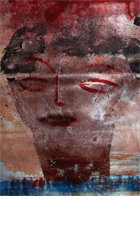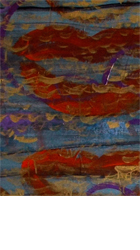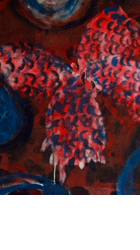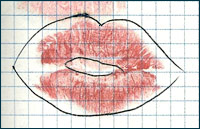images [imaʒ]
The French title of this catalogue is quite contrary to today's anglophone trend. This, however, is understandable knowing that the artist Christine Nehammer-Markus engages with verve and enthusiasm in French language and culture.
Etymologically the term image goes back to the Latin word imago: image, bust, painting, (ancestral) portrait, wax mask, likeness, silhouette, vision, phantasm, simulacrum, reflection, delusion, sight, shape, illustration, allegory, metaphor, imagination, appearance.
Employing these terms is a first step in the understanding of Christine Nehammer-Markus's paintings, which are multi-layered in their palimpsest-like structure. Over time the artist developed her own imagery, repeatedly employing symbols such as floral elements, faces, lips etc. The overall image represents a feminine artist whose images offer glimpses of and access to her personal world and world view. Despite the representational symbolical signs every viewer will see a different image, because the Greek term σύμβολον (symbolon) denotes an object broken into two parts. By uniting these parts it becomes a distinctive marker; thus, the sign only becomes the whole, a symbol, when the observer adds his personal experiences to his viewing of the paintings. The images offer a direct contact with the artist, a direct confrontation with the painting, without any explanatory titles.
The second companion in our analysis of Christine Nehammer-Markus' work is Philostratus the Older, the founder of the communication of art. In his book imagines (3rd Century AD) he describes his sojourn in Naples where he met the son of his host. Looking at some murals the ten-year-old asks him about the meaning of these imagines. In due course and throughout the book Philostratus addresses the child, explaining the arts for him, and at the same time the reader. Spanning time his voice still reaches us demonstrating that there is nothing like understanding the beauty of Christine Nehammer-Markus' images with the vision of a child.
Carmen CH Petrosian-Husa, 2018 |
Paradise of Lips
He only saw round lips that were formed like shells. Were these natural lips or painted lips, he asked himself. He loved shells more than anything, and it was very important for him to know, if shell-shaped lips occur in nature. He had posed the wrong question. These were lips created like this and it was true that they were painted, but somebody had given these lips this gorgeous form, which was created by nature.
Caroline Vopava |
Four persons, who had painted their lips with lots of lipstick, kiss the piece of paper that is lying in front of them on the table. Two of them used a very good lipstick, a lot of color is visible on the paper. One person is of the opinion that one could see love, the other thinks that it is neither sensuous nor erotic, but simply an esthetic form. The third and the forth persons also think that lips involve an esthetic form. Small lips, wide lips, they are an image of life's beauty, most of all of nature; maybe they talk about love, about the things, which are really important. Of course the depicted lips force their existence upon the viewer.
Caroline Vopava |
A part of perfection is about this.
"Kiss me", she said to the stranger, "but kiss me on the mouth". The man hesitated; he did not know the woman well. However, when looking for a while into her face and seeing her mouth, he knew that he had to kiss the woman; he had to feel her lips onto his lips and he had to feel and smell her. She stood up there on the deck of a ship; one hand on the reeling. Her blue dress with the white flowers was whirled to and fro and all around her. At one point a gust of wind whirled her dress totally into the air so that one could see her naked body, but there were nobody looking; and even when, there were no surprised or disdainful glances. The man kept on kissing her on the same spot. She interrupted the kiss and glanced to the right, far onto the sea. I could see her beautiful rose-orange red lips.
Caroline Vopava |
When talking with Christine Nehammer-Markus about her paintings she describes the motives' frequent repetitions in her paintings as a metaphor of daily life. "Similar appearances often are not identical. A day repeats itself and still is always different." With such a statement Christine Nehammer-Markus postulates the serial composition in her work as a symbol. Her main motive in the large paintings is the depiction of the woman. With the help of a stencil from the fifties, she tabs the figure in a serial manner, colours it and subtly changes it each time. These graphics do not represent allegories, but are symbols of her femininity and everything female: symbols of feelings, necessities and hopes that cannot be described in words.
Andreas Lebschik, 1998 |
"I am awfully sorry", she said with a thin-lipped twitching mouth, yet all her waiting was in vain. Dashiell Hammet
red, naturally red are the lips' prints. Fleetingly traces are given shape, lines seeking to frame fringed mouths – lines that want more than just to mark the contour, lines that only enhance and do not correct. The uncertainty about the opposite gives raise to uneasiness: "True, even when some subtleties evade me, I still entertain doubt – not concerning this or that but quite generally."
Markus Mittringer |
The reuse of old canvases is well documented in the history of art. Usually the old paintings were covered with an undercoating and then new paintings created over them. Christine Nehammer-Markus' paintings from the year 2013 though are different; here we have old paintings that have been washed and scrubbed before the new paintings were painted directly over them, without any undercoating. Thus, the definition of a palimpsest has been met:
A palimpsest is a manuscript page from a scroll or book from which the text has been washed off and which can be used again. Romans wrote on wax-coated tablets that could be smoothed and reused, and a passing use of the term "palimpsest" by Cicero seems to refer to this practice.
http://en.wikipedia.org/wiki/Palimpsest
In the famous Archimedes Palimsptest, Archimedes' text was over-written by a Christian liturgical text. In 1924, Sigmund Freud developed the palimpsesting model of the human brain in his paper Notiz über den Wunderblock where all traces of former impressions remain preserved in form of invisible impressions. In the middle of the 19th century the palimpsesting technique has been used as a metaphor for intellectual and creative processes. This brings us back to Christine Nehammer-Markus' palimpsests. She uses more than twenty-year-old paintings as the undercoat of her new paintings. At the same time this undercoat represents Christine Nehammer-Markus' artistic development; as an element of the past it is linked to the present and represents the passage to her present-day artistic views and ways of expression. In the palimpsests of Christine Nehammer-Markus we not only find the washed out visible traces of her old works but also the invisible impressions of her development as an artist.
Carmen CH Petrosian-Husa, 2013 |












